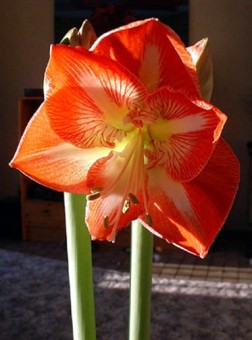
|
|
Amaryllis (Hippeastrum)
|
Amaryllis (Hippeastrum)
The spectacular
"amaryllis" bulbs that are forced into bloom by the thousands every
year are actually hybrids of the dozens of species of the genus Hippeastrum
While the belladonna lily (Amaryllis belladonna) is the true amaryllis,
we use "amaryllis" as a common name when referring the Hippeastrums.
Whatever you call it, this amaryllis is a large tropical bulb with a long
history of brightening up wintertime households. Amaryllis typically holds 2 to
7 huge, 6 in (15 cm) lily-shaped blossoms on massive 18-20 in (46-51 cm) stems.
The dark green straplike basal leaves (arise from the ground in a rosette) are
16-20 in (41-51 cm) long give the plant interest even when not in bloom. There
are more than 50 species of Hippeastrum that bloom white, pink, red or
orange, sometimes striped or frilled and these have been hybridized into a host
of shapes, colors and sizes. Some old favorites sold for indoor container
culture include: 'Apple Blossom' which has white petals with a pink blush, 'Picotee'
is also white with petal edges lined in pink and 'Lady Jane' which has double
petals in salmon-rose.
According to the classical
poets Theocritius, Ovid, and Virgil, Amaryllis was a virginal nymph, timid and
shy but with a spine of steel. She fell head over heels in love with Alteo, an
icy-hearted shepherd reputed to be as handsome as Apollo and as strong as
Hercules, and determined that she would be true only to him, no matter what the
consequences. Indifferent to her charms, Alteo claimed his only desire was that
a new flower be brought to him, a flower that had never before existed in the
world. Amaryllis consulted the Oracle at Delphi and was instructed to pierce her
heart with a golden arrow at Alteo's door. This she did, dressed in maiden's
white, for thirty consecutive nights, dripping blood all the while. The shepherd
finally opened his door to discover a flower with crimson petals, which had
sprung from the blood of Amaryllis's heart.
Amaryllis, whether female
or flower, has been lauded by later poets as well. Artists and photographers,
too, have found inspiration in the flower.
However, the bulb we call
amaryllis is not technically an amaryllis at all. Its taxonomy, while charming,
is confusing and demands clarification. The actual genus Amaryllis contains only
two species, A. belladonna, commonly known as the cape belladonna lily, and A.
paradisicola; both come from the Cape Province of South Africa. Hippeastrums
come from South America and first mentioned in Europe as the American lily with scarlet flowers called
Belladonna like the Cape
Belladonna lily. Carolus Linnaeus (1707 - 1778), the father of botanical
classification put both species under the same group and
named the group Amaryllis, in homage to the beautiful nymph, the name that persists to this
day.
The Honorable Reverend
William Herbert, a British scientist and later dean of Manchester and a leading
authority on the amaryllis of his era, segregated some amaryllis into a new
genus, which he called Hippeastrum, publishing the name change in his book
Amaryllidaceae in 1837. Today Hippeastrum (hip-ee-ay-strum) remains the correct
genus name for cultivated amaryllis hybrids.
The horticultural public, however, has failed to embrace the new
name, and Hippeastrum hybrids still
retain the common name amaryllis. Today the genus-in the Amaryllidaceae family-includes
over fifty species, from which hundreds of cultivars have been bred.
History is murky as to
when the amaryllis was discovered in South America. The species hail from the
Andes Mountains of Chile, Peru, and Bolivia as well as from Brazil, Argentina,
and Venezuela and as far north as Mexico and the West Indes. H. puniceum, H.
reginae, H. striatum, H. reticulatum, and H. vittatum, probably in that order,
were brought to Europe in the latter half of the seventeenth century, and
additional species continued to be introduced as they were found.
In Holland, commercially
grown amaryllis, generally propagated from offsets or from twin-scaling, are
primarily grown in large-scale greenhouse operations. Bulbs are planted from
October to March and harvested by hand from July to October, when all their
leaves are removed, chopped, and incorporated back in the planting beds. After
harvesting, bulbs are quickly dried and cured. The old root system must remain
viable.
While Holland and South
Africa dominate in bulb production today, new hybrids are being developed in
North America, Australia, Japan, India, Israel, and Brazil.
Source:
http://www.botany.com/hippeastrum.html
http://www.flowers.org.uk/flowers/facts/a-d/amaryllis.htm
http://www.gardenguides.com/books/amaryllisexc.htm
http://www.rbgkew.org.uk/archive/events/HipWeb/HipPort.htm
http://www.floridata.com/ref/h/hippeast.cfm
